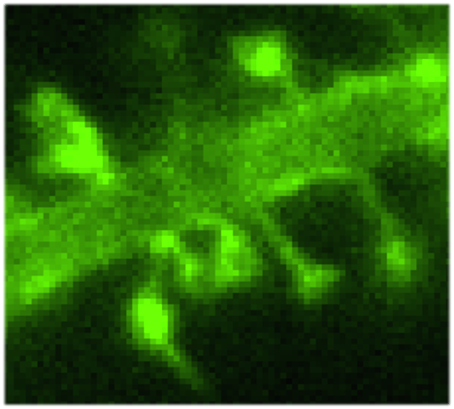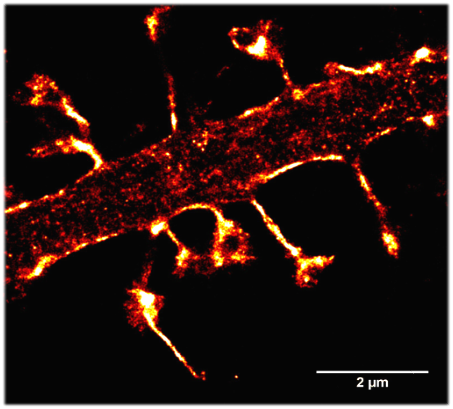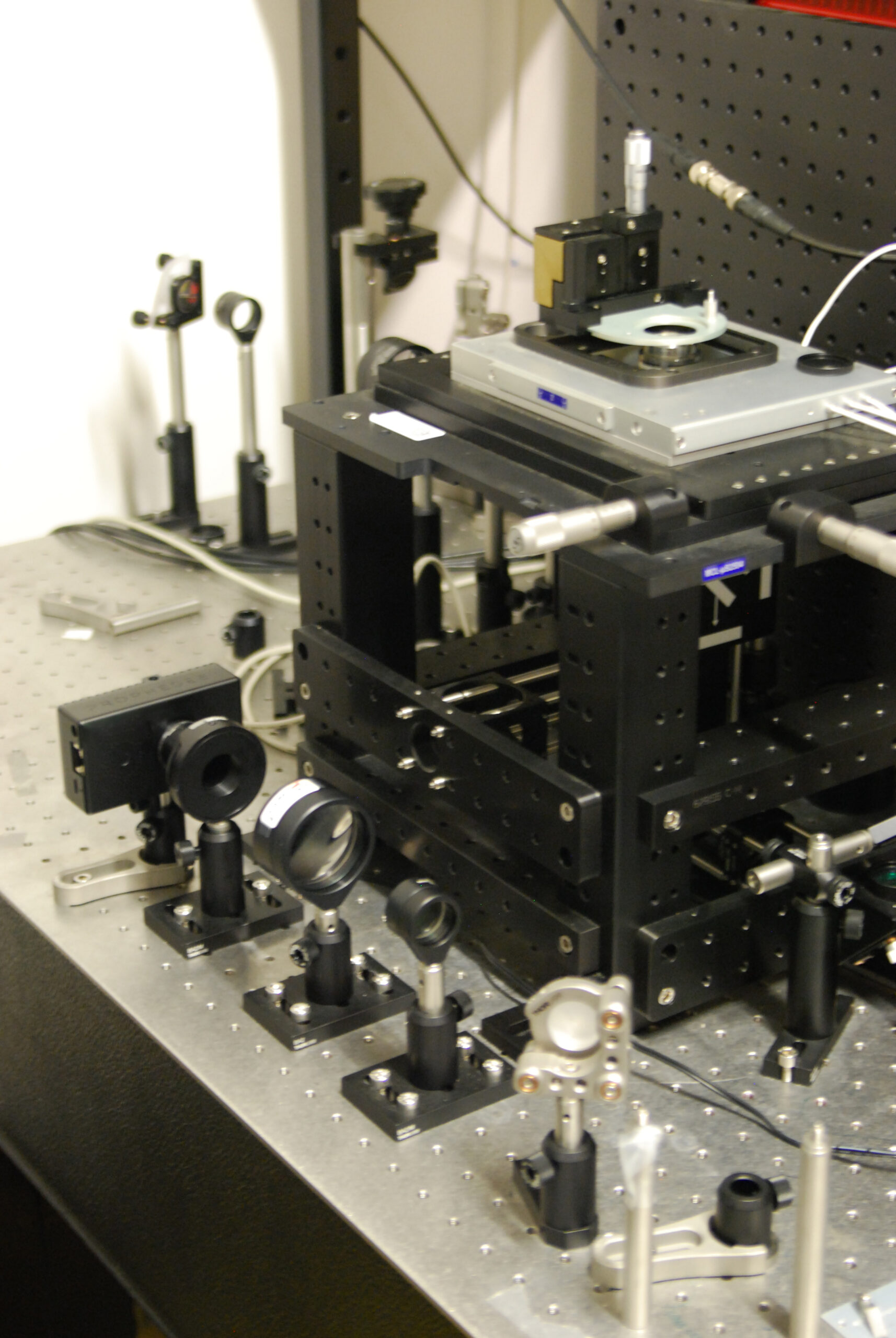EVENT-BASED VISION UNLEASHES UNFORESEEN POTENTIAL FOR SUPER-RESOLUTION FLUORESCENCE IMAGING
Super resolution imaging
down to 25nm resolution
Outperforms frame-based cameras
in high-density conditions
10x faster acquisition
than with frame-based cameras
Compatible
with most camera-based microscopes
Reduced
data volume
Increased
information content
Breaking the Limits: Super-Resolution Microscopy Unveiled
Throughout history, optical microscopes were confined by the diffraction limit of light, capping their resolution at 200-300 nanometers. However, dedicated efforts by researchers in the 21st century shattered this barrier, culminating in the 2014 Nobel Prize in Chemistry for advancements in super-resolution fluorescence microscopy.
A pivotal technique, Single-Molecule Localization Microscopy (SMLM), hinges on tagging proteins with intermittently blinking fluorescent molecules, enabling precise individual localization at the nanoscale. Consequently, super-resolution images are pieced together akin to a pointillist painting, surmounting diffraction-limited resolution by an order of magnitude or more.
Despite revolutionizing the exploration of cellular structures and biomolecular interactions, SMLM encounters constraints in temporal resolution owing to conventional camera technology. These cameras necessitate photon accumulation during exposure before synchronized readout, hence limiting imaging speed.

Resolution ~250nm

Resolution ~25nm
Izeddin et al, PloS one 2011
Cytoskeleton of dendritic spines of neuronal cells
“Eve-SMLM provides new opportunities for single-molecule applications in which classical frame-based cameras are unable to perform, as we showed in the case of high-density acquisitions.”
Cabriel, C., Monfort, T., Specht, C.G. et al. Event-based vision sensor for fast and dense single-molecule localization microscopy. Nat. Photon. 17, 1105–1113 (2023). https://doi.org/10.1038/s41566-023-01308-8
Revolutionizing SMLM: Event-Based Vision Sensors for
Super-Resolution Imaging
Pioneering research has marked remarkable advancements in super-resolution fluorescence imaging, propelled by the adoption of event-based sensors. The synergy of researchers at the Institut Langevin (ESPCI Paris, CNRS, PSL University), in collaboration with DHNS (INSERM, Université Paris-Saclay) and the Institut de la Vision (CNRS, INSERM, Sorbonne Université), showcases the superior performance of these sensors over conventional scientific cameras in the realm of single-molecule localization microscopy (SMLM). This collaborative effort has effectively extended the frontiers of temporal resolution.
Blinking (left) and super-resolution reconstruction (right) of the same region of tubulin labeled with Alexa Fluor 647 fluorophores in fixed COS-7 cells using an event camera*. The total acquisition time is 50 seconds, accelerated for reconstruction visualization
Neuromorphic vision sensors, also known as event-based vision sensors, diverge from the workings of traditional cameras. Modeled after the human eye, these sensors comprise asynchronous pixels that swiftly react to changes in brightness with exceptional temporal accuracy. Boasting low power consumption, minimized data load, rapid response rates, and cost efficiency, event-based vision sensors hold immense promise in biological imaging. Their forte lies in capturing the asynchronous and dynamic nature of SMLM fluorophores.
Researchers have triumphantly introduced Eve-SMLM, an event-based approach to single-molecule localization microscopy. This innovation not only generates super-resolution images on par with traditional scientific cameras in terms of quality and resolution but also triumphs over the complexities of high-density imaging, wherein overlapping images of individual fluorophores pose a challenge. Unlike conventional cameras that stumble in such scenarios, Eve-SMLM thrives by discerning ON and OFF transitions, extracting vital information, and executing efficient temporal resampling.

Setup used for Eve-SMLM with Prophesee
event-based vision sensor Gen4
“The event-based detector has a much more rapid response to changes, with signals being detected in a millisecond or less in typical single-molecule imaging conditions. Under the same conditions, a traditional camera requires an exposure time of 35 milliseconds to collect enough photons and create well defined localizations.”
Dobbie, I.M. Event-based super-resolution microscopy. Nat. Photon. 17, 1028–1030 (2023). https://doi.org/10.1038/s41566-023-01312-y
2D SMLM of COS7 cells, alpha-tubulin labelled with Alexa Fluor 647*
Imaging of fluorescent beads with square modulation of the excitation at 10Hz, slowed down 10x for visualization*
*Green represents positive events and red represents negative events
“Unlike cameras, which integrate photons during a set exposure time, event-based sensors react to changes in light intensity, and each pixel returns a signal only in response to such changes. In these sensors, each pixel is independent, and meaningful data are generated only by blinking single molecules, which offers unique advantages, especially for detecting closely spaced emitters.”
Strack, R. Better detection for localization microscopy. Nat Methods 20, 1873 (2023). https://doi.org/10.1038/s41592-023-02132-2
Unveiling the Potential: Eve-SMLM Redefines Single-Molecule Microscopy
Eve-SMLM stands as a landmark moment for single-molecule microscopy and its applications. This novel technique could be instrumental in probing multi-scale spatial and temporal processes prevalent in biology. The research serves as a testament to the transformative potential of event-based detection in super-resolution fluorescence imaging, heralding fresh vistas in biology, medical applications, materials science, and beyond.
ABOUT THE LANGEVIN INSTITUTE
Institut Langevin is a joint research unit between ESPCI Paris and CNRS. It obtained in 2011 the French government label “LABEX” (laboratory of excellence) for the project WIFI (Waves and Imaging: From Fundamentals to Innovation).
The Langevin Institute combines fundamental research, applied research and business creation in a very multidisciplinary spirit.
The spectrum of waves concerned is very broad: mechanical waves (acoustic, elastic and seismic waves, waves), electromagnetic waves (radio frequencies, microwaves, Terahertz) and optical (infrared and visible).
The Institute’s researchers aim to understand the propagation mechanisms of these different types of waves in the most complex environments and to take advantage of this better understanding to design original instruments for the manipulation of these waves and the imagery of these environments.
ABOUT DHNS
The “Diseases and Hormones of the Nervous System” research unit works to meet unmet medical needs in the field of diseases of the nervous system. The objectives are the protection of nerve cells, the improvement of neuroregeneration, including the regeneration of myelin sheaths, and functional rehabilitation.
It is based on two teams and on the medical environment of the Bicêtre hospital which carries out complementary work around 4 main axes: Myelination, myelinopathies and remyelination, Proteinopathies: from mechanisms to therapies, Steroids and neuroregeneration and Therapeutic innovations.
ABOUT THE VISION INSTITUTE
The Vision Institute is one of the largest integrated research centres in Europe dedicated to vision diseases. Conceived as a place of gathering and exchange, it brings together researchers, doctors and industrialists around patients, and is the leading vision research centre in the world. The Institute’s goal is to discover, test and develop treatments and technological innovations of tomorrow in order to prevent or limit visual impairment and to improve the autonomy and the quality of life of patients.
ABOUT PROPHESEE INVENTORS COMMUNITY
Since 2014, a network of researchers, start-ups and companies have shown incredible imagination and innovation using Prophesee’s neuromorphic vision technologies.
This has created an Event-Based Vision ecosystem of inventors sharing their work and ideas. Their creativity with Prophesee’s technologies inspires us.
We are gathering them here to inspire future inventors in turn, in the hope that, like the projects here, they create something new together and reveal the invisible.
Don’t miss a bit,
follow us to be the first to know


